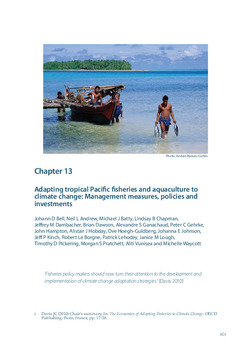Adapting tropical Pacific fisheries and aquaculture to climate change: management measures, policies and investments

Citation
Bell, J.D. et al. (2011). Adapting tropical Pacific fisheries and aquaculture to climate change: management measures, policies and investments. p. 803-876. In: Bell, J.D. ; Johnson, J.E. ; Hobday, A.J. (eds.) Vulnerability of Tropical Pacific Fisheries and Aquaculture to Climate Change. Secretariat of the Pacific Community, Noumea, New Caledonia
The main purpose of this book is to assess how changes projected to occur under low (B1) and high (A2) emissions scenarios in 2035 and 2100 could derail plans by the Pacific Island countries and territories (PICTs) to use the sustainable benefits of fisheries and aquaculture to foster economic development, government revenue, food security and livelihoods. This chapter sets out the information needed by stakeholders in the fisheries and aquaculture sector at all levels to reduce the threats and capitalise on the opportunities created by climate change The authors emphasise that adaptations and policies to build the resilience of the Pacific communities to climate change should not be viewed just from a scientific or technical perspective - the needs and aspirations of people must also be integrated. Understanding how people are affected, and how their traditional knowledge, capacities and perspectives can help develop and implement adaptations is a vital part of the process. Community consultation and participation are essential to ensure that adaptations incorporate a human rights and human development approach to achieve gender equality, maintain relevant traditional customs and culture, and empower young people.
Permalink
Date Available
Type
Publisher
Research Themes
Topics
Language